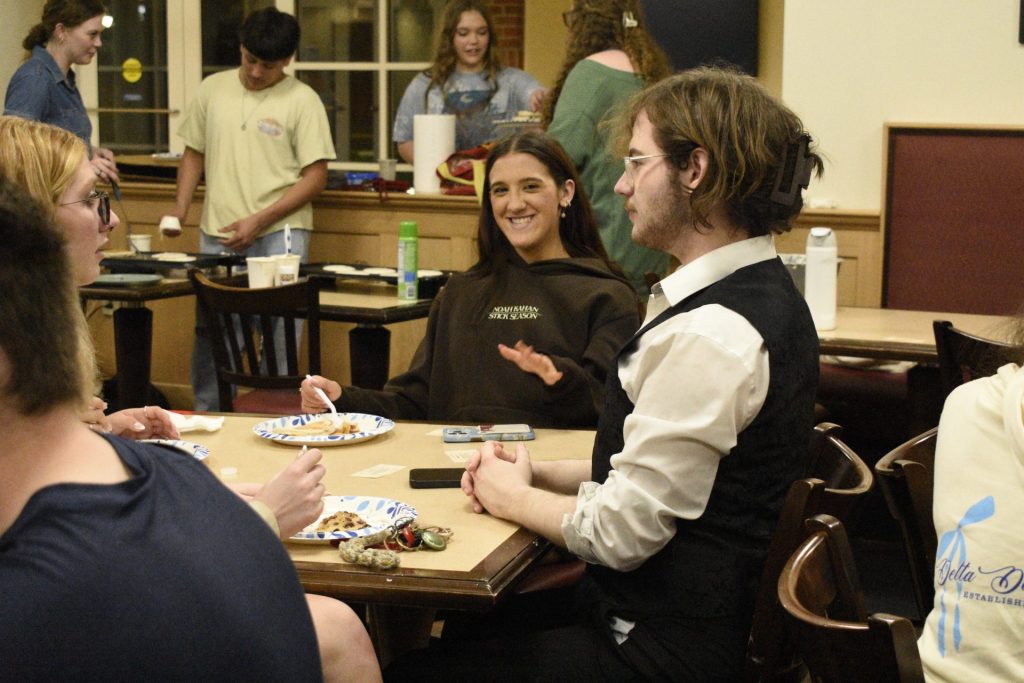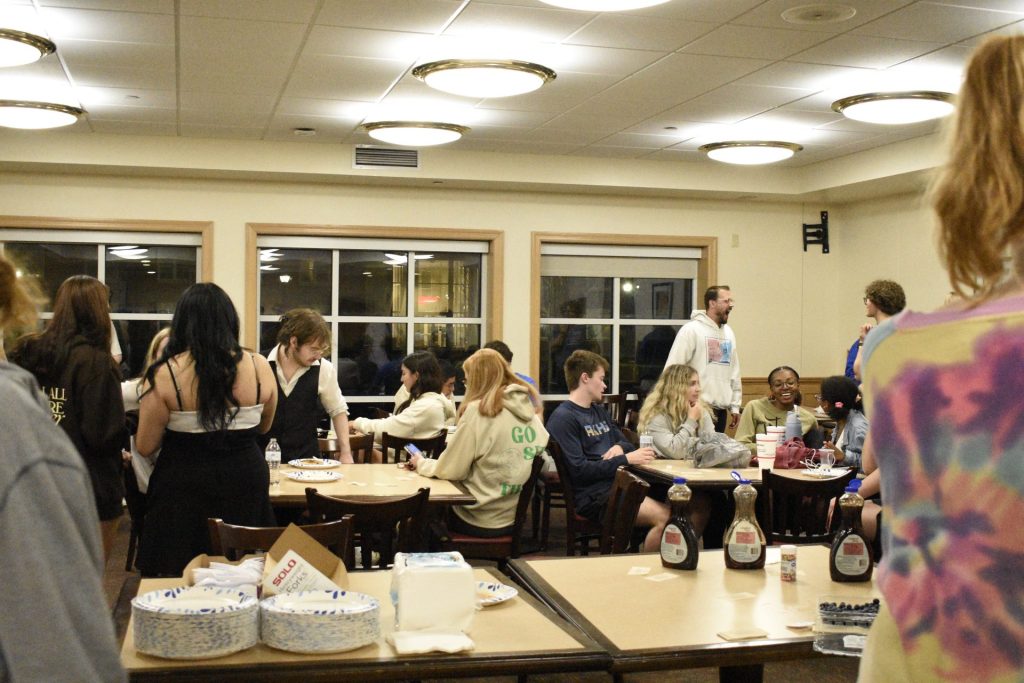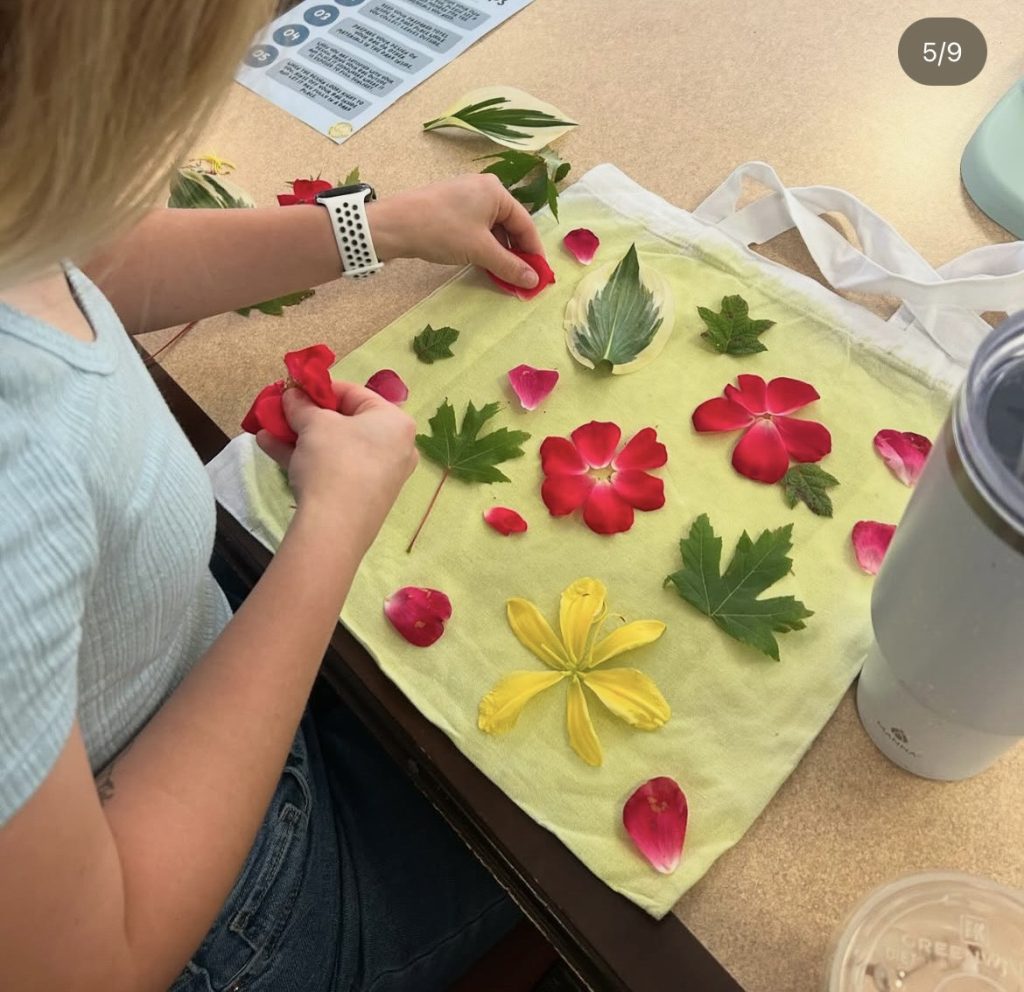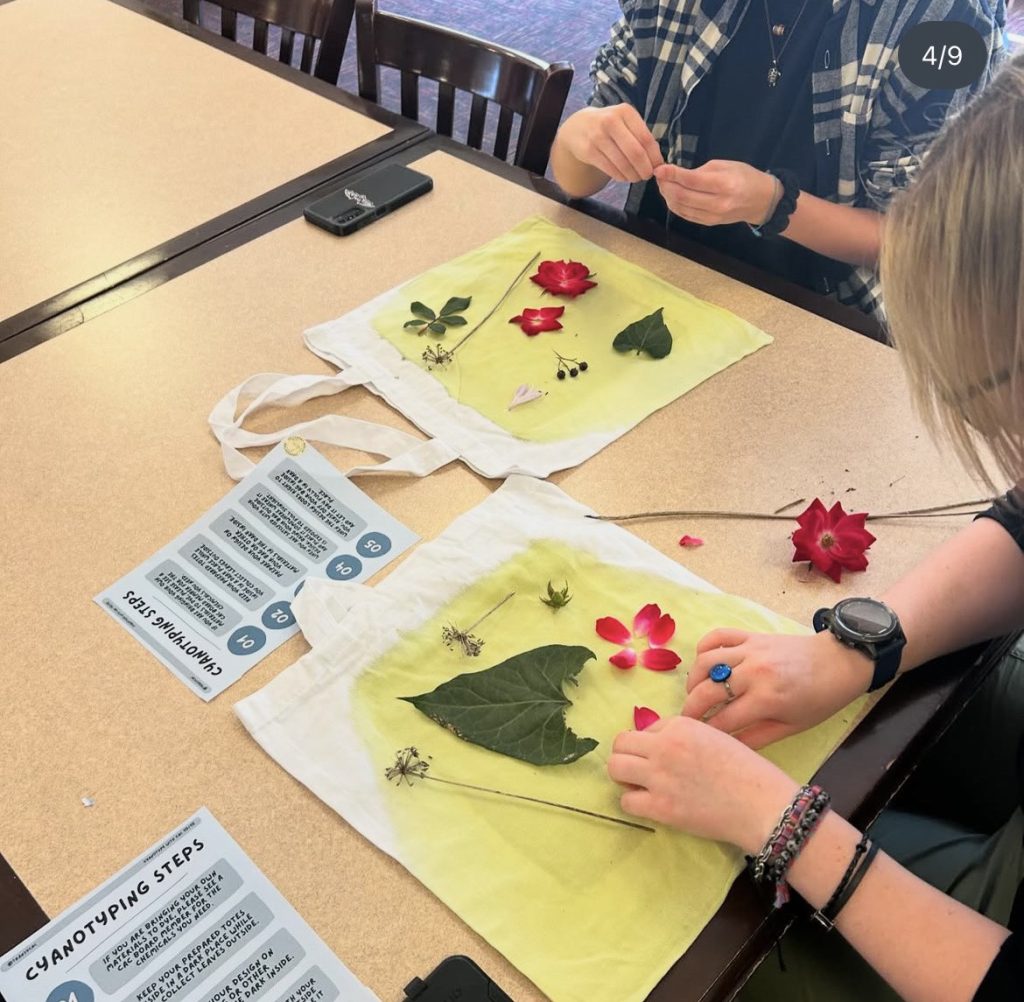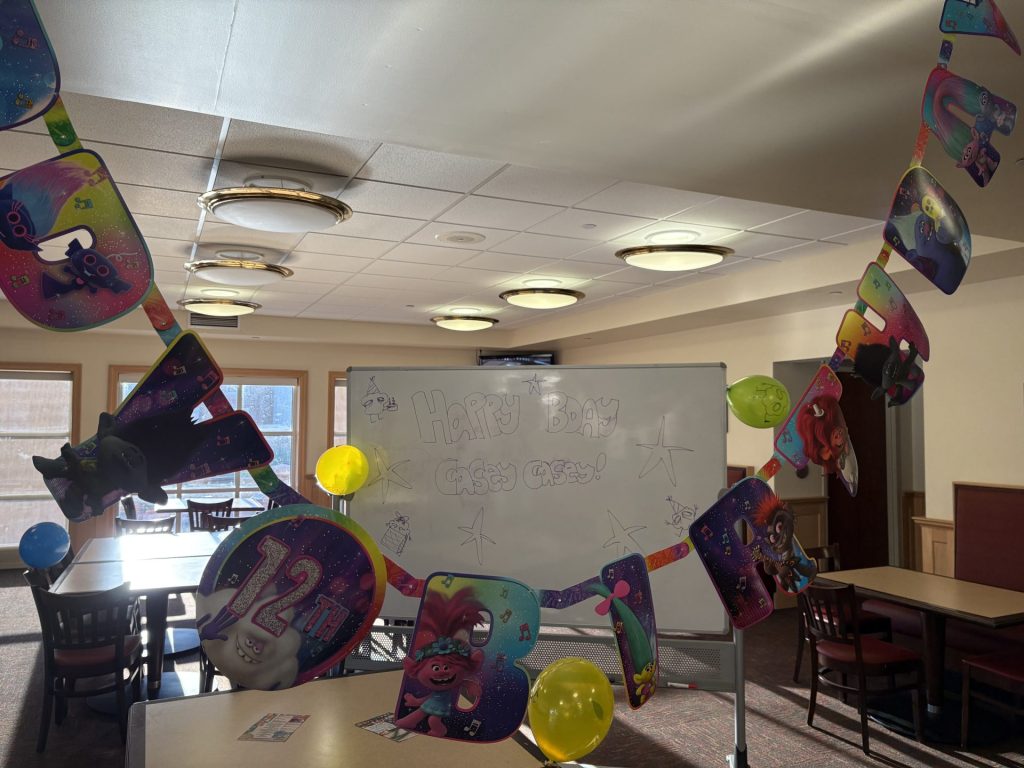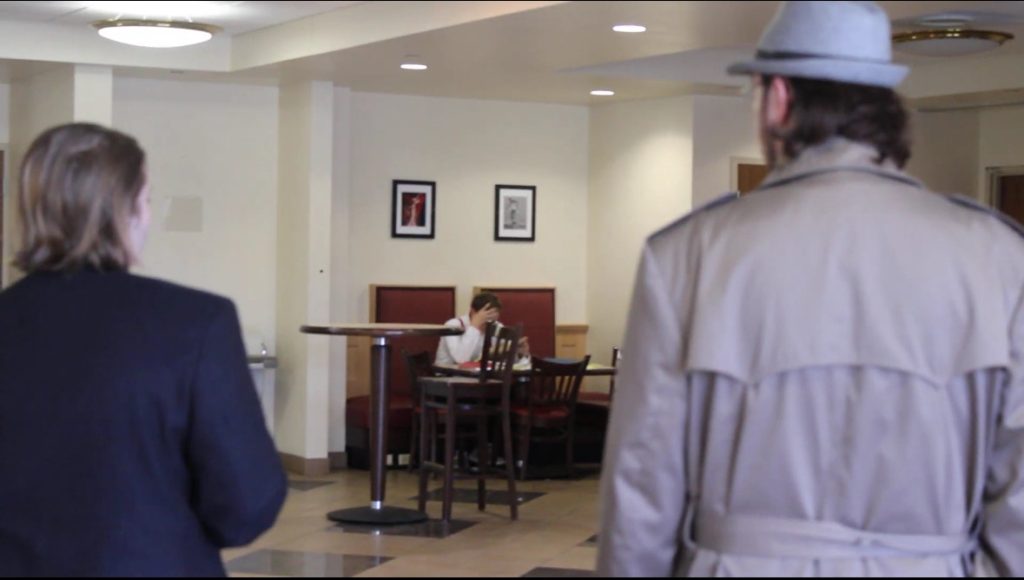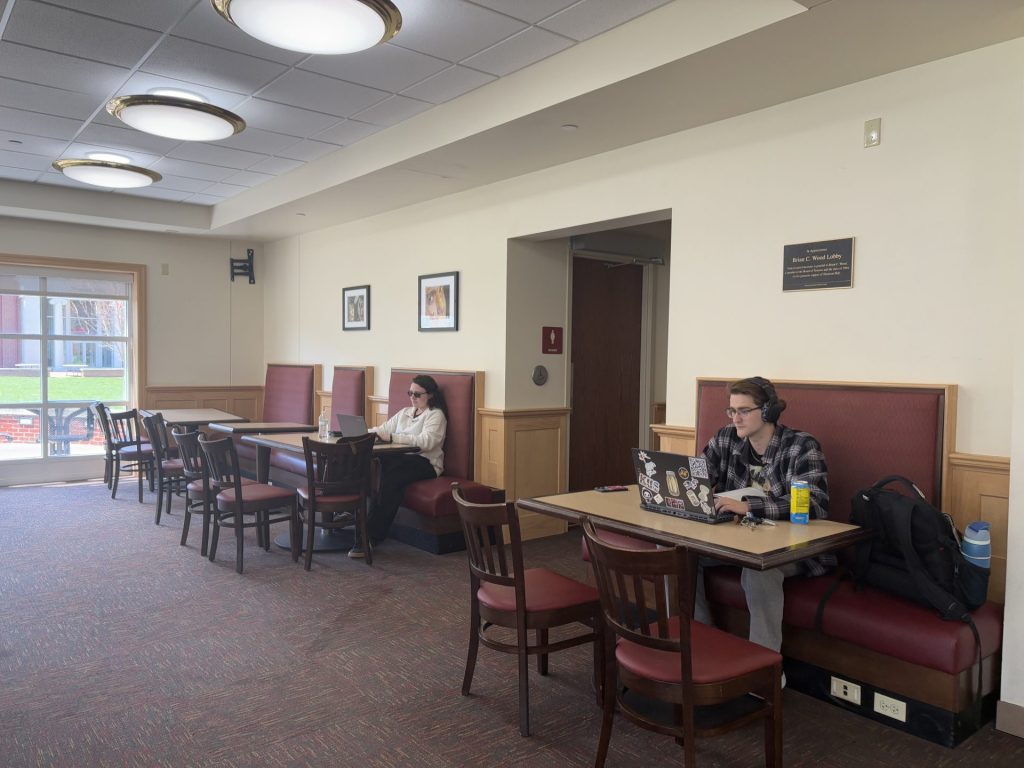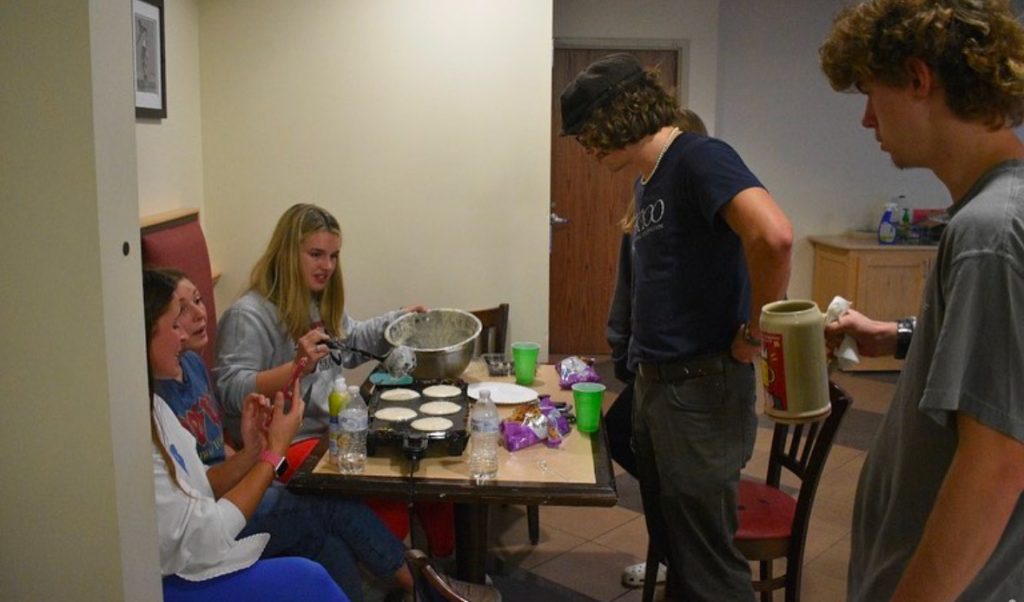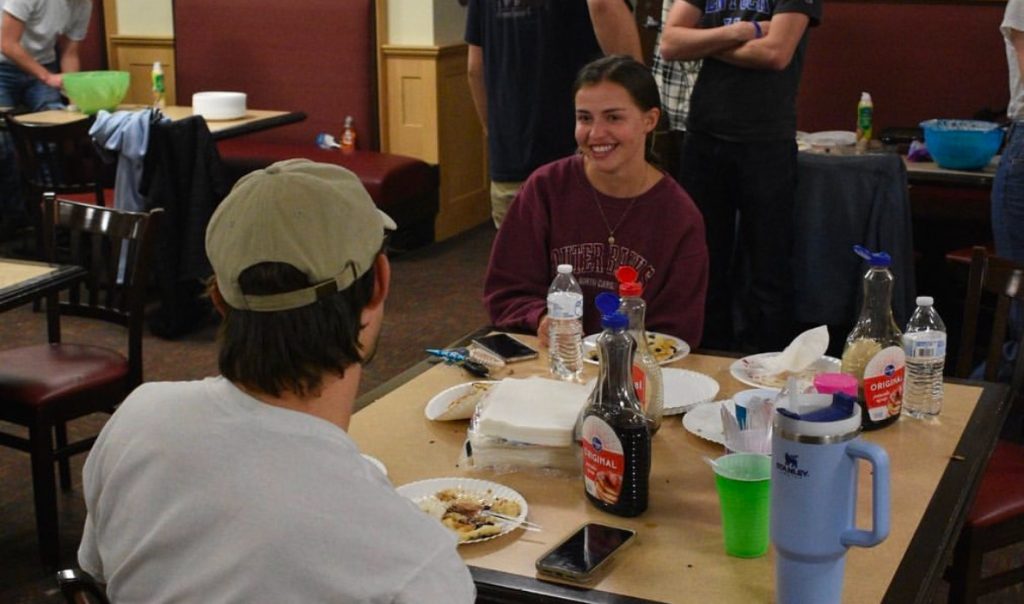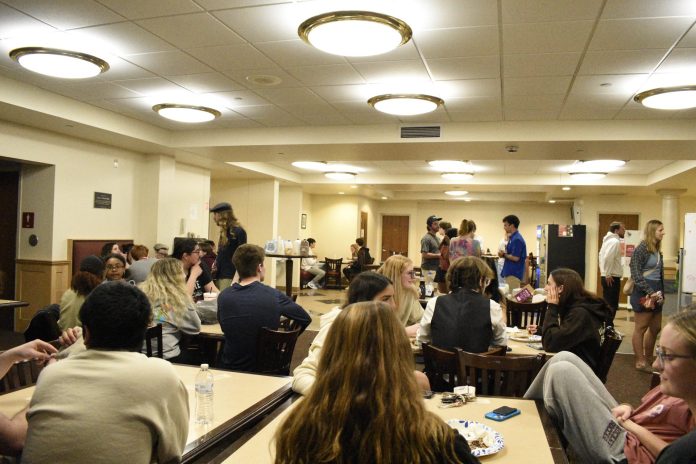The first-floor lobby of Thomson Hall, officially known as the Brian C. Wood Lobby, is one of the most frequently used common spaces on the residential side of the Transylvania campus, and at this moment, the only major common space left on campus that is accessible to all students 24 hours a day. However, this space is under immediate threat due to plans from the administration that have been intentionally hidden from the student body.
Several sources have confirmed to the Rambler that the administration plans to convert the majority of the first-floor lobby into a Virtual Reality (VR) lab for the 2025-26 school year, with construction in Thomson Hall set to begin as early as this May Term. VR labs are large open areas that allow users to don VR headsets and interact with a virtual environment, obstacle-free. The current plan would involve walling off the majority of the lobby – the carpeted section with tables and booths where the majority of students gather- and removing all the furniture. This new space would only be accessible via a crimson card reader. It is unclear how many people would have access to this VR lab and at what times a day. The communal bathrooms for Thomson Hall would be only accessible through the lab, so it is essential that at least Thomson residents have continual access to the space. As for everyone else, it seems likely that it will be a similar arrangement to the esports lounge in the Thomson basement and various DART labs on the academic side of campus: limited general access during open hours and access only to those with special permission after hours.
Sources for the Rambler have confirmed that the funding for this project is coming from a recent $2 million grant from the Bingham Fund for Excellence in teaching at Transylvania, a fund that has the expressed purpose of investing in innovative classroom techniques at Transy. A press release from the Office of Marketing and Communication, released in the 1780 blog on the morning of Friday, April 2, said the following about the exact goals of the grant:
The $2 million investment prioritizes two key areas that create an enhanced student experience: classroom modernization and the further development of innovative digital learning spaces. Recognizing the classroom as the cornerstone of Transylvania’s educational experience, the plan allocates the largest portion of funding to upgrading dozens of classrooms with state-of-the-art technology. Additional targeted investments will be used to enhance campus DArt Labs (digital arts spaces), giving students and faculty access to cutting-edge resources and adaptable environments that foster creativity and interdisciplinary collaboration.
Nowhere within the press release is the specific plan of converting the first-floor Thomson Lobby into a VR Lab mentioned. In fact, despite the start of construction being less than a month away, there has been no official announcement from the university on the plans for Thomson Lobby. The only previous indication that a renovation was coming for Thomson lobby was IT preemptively removing features from the lobby, such as the two student-accessible televisions.
This plan for the lobby becomes the second instance in a developing pattern of unannounced renovations of student common spaces. Over the past summer and stretching into the fall semester, the building that previously was solely Rosenthal Commons, the other student common space that had 24-hour access for all students, was transformed into the Sanders-Siebers Entrepreneurship Center. While the directors of the Entrepreneurship Center have made commendable efforts to keep the space open for all students, the current space is ultimately designed for classes and events; it looks and feels like a Cowgill classroom that has been placed on the residential side of campus. And while Rosenthal Commons had fallen into something of a state of disrepair by the end of last year, the Thomson first-floor lobby remains in relatively good condition and is used much more than Rosenthal Commons was.
An anonymous Thomson Hall resident spoke with the Rambler about how the lobby is used both by those living in the building and the campus community as a whole. They said, “I see residents using the Thomson lobby at all times of the day…Residents tend to use it for studying, but many campus organizations use it as well.” The lobby has served as a convenient meeting location for all sorts of campus organizations. It has been utilized by FSL organizations for chapter events and as a meeting space before formals. Campus organizations, especially those hosting events later in the night, also often use the lobby; a frequently cited example was Transy Cru’s Midnight Pancakes event that is held in Thomson Lobby every semester.
This consistent usage shows that the first-floor Thomson lobby has been one of the most popular third places for students on campus. Third places are usually defined as physical spaces that are not homes (first places) or workplaces (second places) that facilitate social interaction. A 2019 article published in the peer-reviewed public health journal Health & Place spoke to the characteristics and benefits of third places, stating:
These third places span a diversity of locations that are all defined by their ‘ordinariness’ – simple, unassuming, and usually affordable places to ‘hang out.’ People can meet, express themselves, relax, play, and build community, often at little material cost or personal effort. Beyond single instances of individual-level social interaction, third places can serve to generate social surplus: collective feelings of civic pride, acceptance of diversity, trust, civility, and overall sense of togetherness within a locale through sustained use and connection among residents
When looking at the Transylvania community, and considering classrooms and other educational spaces as a university’s second places, there are admittedly a number of third places for students, such as the Great Hall (or Caf), the Beck fitness center, the library, and businesses close to campus like Third Street Stuff. However, all of these locations are held back by factors like limited hours or monetary barriers to entry, something that can not be said of the Thomson lobby. While the second and third floor lobbies could also be considered ideal third spaces under these criteria, they are much smaller than the first-floor lobby and less suited for usage by multiple groups at a time. Additionally, the upper-floor lobbies are more out of the way of students, with the majority of students not even realizing that they have open access to the lobbies from the stairwell, something that is not the case in any other residential building.
The planned renovation of the Thomson lobby into a VR lab would turn it from a space that is open to and widely used by all students to one where it is currently unclear how much it would be used by students. Various students who have spoken to the Rambler have suggested that while they have seen Virtual Reality integrated into a few classes, it is currently fairly limited in scope. The Bingham grant that is providing the funds for the VR lab renovation likely includes funding to encourage more classes centered around VR experiences, though it is unclear what is specifically being done to encourage the VR lab to be used since no details have been announced to the student body. It is also unclear how classes that utilize VR will work around the fact that the lab will be located on the residential side of campus, far from every other academic building. Will professors hold classes inside the lab? Will classes be led to the other side of campus to use the lab? Or will professors require students to complete assignments in the lab outside of class? While some of this would undoubtedly be up to the discretion of individual professors, the lack of any transparency about how the lab will be used certainly does not help.
Classes that currently utilize VR technology do so in the basement of Mitchell Fine Arts, in the former Rafskeller space. Student Government Association President Sean Gannon told the Rambler that preliminary plans called for the lab to be placed in Hazelrigg Hall, which has sat empty on the academic side of campus for many years. This would be in collaboration with proposed technology-based renovations of Hazelrigg as part of Transylvania’s 2030 Master Plan. However, structural issues within Hazlerigg such as low ceilings led to the Thomson lobby being identified as a better space for the lab. Gannon suggested that there were still plans calling for an eventual VR lab on the academic side of campus, whether in a refurbished Hazelrigg or in a new connecting building between Hazelrig and Brown Science Center. If these admittedly unconfirmed and highly speculative proposals were to pan out, what would be the fate of the Thomson VR Lab? Would there be enough support for two separate VR labs on opposite sides of campus, or would Thomson lobby then be re-renovated back into a purely common space? With the goals of the 2030 Master Plan even less clear to students than the current Thomson lobby renovation plans, it will likely be a long time before any clarification can be expected.
The lack of communication to the student body on the planned renovation of the Thomson lobby shows a troubling lack of transparency from the highest levels of Transylvania’s administration, one that is forming part of an unfortunate pattern when considering the transformation of Rosenthal Commons. It shows a profound arrogance on the part of the administration to not only hide this information from the student body, but from most faculty and staff as well, going above the heads of staff members who put in the work to connect with and hear the concerns of students. The lack of student consultation is another example of Transylvania leadership, especially the Board of Trustees, being totally out of touch and living in willful ignorance of the wishes and needs of students; notably the Transylvania Board of Trustees is just one of three private colleges in Kentucky that does not have a sitting student government representative. Personally, the response I have seen from students when told of the lobby plans follows in an unfortunately common belief among students: that Transylvania’s highest leadership is not actually concerned with the wishes of the student body, and that this seems like the administration grasping for something new and shiny to dangle in front of prospective students and raise enrollment numbers. And while, again, the renovation is coming from directed outside funding and can only be used for specific projects, it is sadly ironic that in a time where the university points to a lack of funding for why many issues go unaddressed, funding has come quickly for a project that much of the student body is actively against.
If you are also concerned about these renovation plans for Thomson Lobby, share your concerns with Vice President for Academic Affairs and Dean of the University Dr. Rebecca Thomas, who is currently acting on behalf of President Brien Lewis during his leave of absence, through academicdean@transy.edu
Additionally, the Rambler has begun a petition on behalf of the student body to show that students do not approve of the plan to convert the Thomson lobby into a VR lab. Physical copies of the petition to sign can be found hung in Thomson Lobby, as well as with the following Rambler leaders:
- Katie Axon (keaxon26@transy.edu)
- Nate Brother (njbrother25@transy.edu)
- Lyra Duffy (laduffy27@transy.edu)
- Brenna Clark (baclark27@transy.edu)
- Madalyn Stump (mestump26@transy.edu)
- Becca Orjala (rnorjala26@transy.edu)
